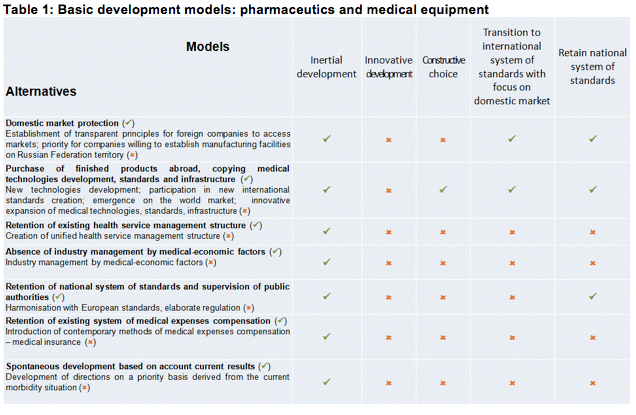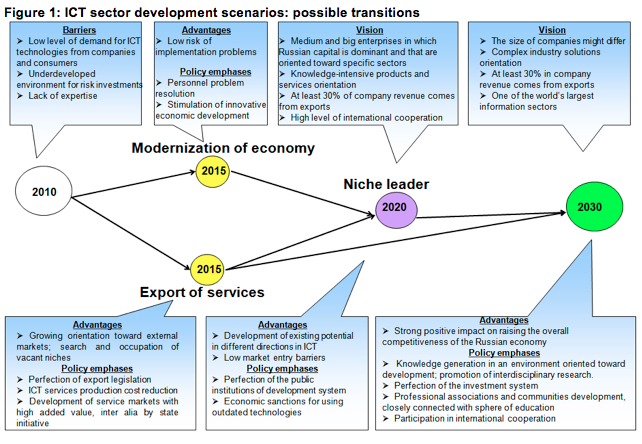The exercise presented includes scenarios of key Russian economic sectors and determines necessary technologies in accordance with such scenarios. As key sectors, the foresight team investigated the energy, iron and nonferrous-metals industry, agriculture, the chemical industry and pharmaceutics, the aircraft industry, commercial shipbuilding and the information sector.
Intensifying Foresight Efforts to Modernise the Russian Economy
Over the last years, we have seen increasing activity of federal and regional authorities in innovation and industrial policy in Russia. This activity has led to a series of documents and commissions concerned with the long-term development of the Russian economy. Among them are industry strategies (in more than 15 sectors), a conception of long-term socio-economic development for the Russian Federation (RF), priority directions for the development of science and technologies, and the Commission for Modernization and Technological Development of Russia’s Economy under the RF’s President.
The year 2006 marked the first “Concept for Long-Term Russian S&T Forecast till 2025” in the country’s modern history. This was developed and approved in cooperation with key ministries and science and business representatives. In 2006, practical steps toward implementing some of the foresight and forecast projects were launched (by 2012 we will have more than 50 key projects at different levels, including the national, regional and corporate level).
The first serious attempt to organise a foresight project at the national level was conducted more than 30 years ago within the Complex Program of S&T Development for the USSR. It aimed at S&T forecasting for a period of 20 years and can be considered a project of the first foresight generation (according to the definition by Georghiou et al., 2008). For the next 10-15 years, there was an absence of foresight and forecast exercises. In recent years, a number of initiatives have been launched to overcome this deficiency (for more information, see Sokolov & Poznyak, 2011).
Modern foresight projects in Russia today are very much in line with the current fifth generation of foresight exercises in developed countries, which includes a focus on social context and a strong policy-advisory orientation. Thus, we can say that Russian foresight development has taken a shortcut in these years and “leapfrogged” directly to what is currently considered the state of the art in foresight methodology.
The main challenges that these projects address are:
- the need for diversification and a decreasing energy-output ratio of national GDP,
- the increasing role of modernisation,
- the transition to the innovation path proposed by the government,
- threats from emerging countries (China, India) to Russia’s traditional markets,
- changes in the global value chain, and the need to find new niches and markets,
- opportunities to cooperate with foreign countries.
The key objectives of these projects are to:
- identify key drivers and trends for the Russian economy,
- identify the most critical technologies,
- elaborate scenarios for key sectors and S&T fields,
- develop policy recommendations at the federal and regional levels,
- identify research priorities,
- build expert networks around research organisations,
- create pilot technology roadmaps for S&T fields and key sectors.
Methodology and Database for Foresight of Russian Economic Sectors
To achieve our aim, the database was based on two pillars. The first included information and relevant data from foreign and Russian forecasts, foresights at the country, industry and corporate level, and key Russian documents on S&T and industry development. The second pillar comprised data from various industry experts, representatives of key industries and consulting companies.
To construct various sector scenarios, we used elaborated qualitative models, which included sector analysis (characteristics of the technological base, organisation structure, role in exports, etc.), the identification of basic strategic alternatives for future sector development (e.g. technological and institutional), the construction of models of sector development, future visions, and the identification of priorities for S&T development in the sector in question for each vision.
This resulted in four to eight prospective scenarios for each key sector. To discuss the preliminary visions and present a final set of scenarios, we held a series of round tables and conferences. We also formed a multi-level pool of experts: the core included so-called “system experts” – high level professionals who were able to provide a comprehensive evaluation of the vision for the sector in question (2-3 persons for each sector); the next level included sector analysts who could contribute in-depth knowledge of different aspects relevant to the particular scenario (e.g., on markets and technologies; 7-12 persons for each sector); the last level was public relations experts and experts familiar with governmental and administrative processes and included representatives of industry journals, key federal and regional authorities (about 10-15 persons for each sector). We conducted focus groups, in-depth interviews and surveys to gain information from the experts participating in the project.
The beneficiaries of the project results are business (large, small and medium enterprises, business associations, industry institutions), government (state institutes for innovation development, federal and regional authorities), science (the system of Russian academies, research institutes), universities (leading institutes and labs in the Russian higher education system), and experts in the fields under consideration.
Project Results: Sectoral Models and Critical Paths
Some of the main sectoral results indicated that key sector development scenarios took institutional and technologic alternatives into account while identifying the main technologies necessary for implementing the scenarios. The results for the various sectors were highly diverse due to different sectoral structures and the number of sectors (ten). The table and illustration below briefly show some results for two sectors.
Medical Equipment and Pharmaceutics
After the sector analysis, we elaborated seven alternative paths of development for the pharmaceutics and medical equipment sector based on a literature review along the criteria mode of regulation, position in value-added chain, degree of modernisation and management. Then we verified alternatives by consulting industry experts and developed the five most probable models.
Information and Communication Technology
In case of the ICT sector, most experts agreed that a transition to the most preferable scenarios (“niche leader” or “technological leader”) cannot be accomplished directly. The only way to achieve them is to establish bridgeheads and use the competitive advantages gained to further advance toward the goal. Each scenario in Figure 1 contains a description of a future vision, possible barriers and risks, pros and cons, and recommendations for a shift in policy.
The exercise led to the following three policy-oriented results: (1) alternative “preferable” visions for the development of key sectors that are not limited only to the simple dichotomy of “bad” or “good” as in major government S&T documents; (2) recommendations for integrating long-term S&T forecasting as a basic instrument for strategic policymaking; (3) formation of a multi-level expert pool to serve as a communication network for discussing and constructing Russian S&T policy.


Foresight Culture Still Underdeveloped in Russia
We believe that the lessons and experience obtained during this project are representative of the whole field of foresight and forecast initiatives in modern Russian history. One of the key success factors in foresight is participation of key stakeholders and experts involved in shaping the future. In the case of Russia (at least 3-4 years ago), a lack of foresight culture has resulted in an “a priori”, indiscriminately negative perception of foresight initiatives. This can be explained historically by the fact that there have been some serious gaps between science and business and, as a result, in the supply of and demand for innovation. Mutual complaints are voiced to that effect. Business shows little interest in projects oriented toward long-term outcomes, lacks receptivity to innovations and displays low levels of global competition. We can say that the key actors (government and business) responsible for shaping the future are not fully up to the task. They have lost the “habit” of planning for a time span of more than 2-3 years.
One of the repercussions of the Soviet heritage is a lack of experts capable of acting as so-called “integrators”: experts able to devise strategies based on combining market pull with technological push. As a result, we have to first nurture a new generation of experts, typically to be recruited from representatives from the “technology” side, with the skills required to adopt a more comprehensive perspective of the sector as a whole.
Apart from qualification, a lack of expert commitment poses another problem in that experts show low interest in collaborative work and are more intent on lobbying and pushing their own individual interests.
Another serious drawback in foresight culture in Russia is an insufficient commitment to the processes required to formulate visions and scenarios on part of federal and regional authorities: they usually want to see “ready-to-use” results instead of participating in the process from the beginning.
We believe that a serious obstacle to the development of foresight culture in Russia is the lack of actually working, sustainable, systematic communication platforms for discussing different foresight results. Only in the past 2-3 years have they grown in number, particularly platforms launched by national research universities, technology platforms, etc. (for further information see Simachev, 2011).
Development of a common “cure” for deficiencies in foresight culture in Russia is complicated by the fact that Russian economic sectors are of a multi-structural nature, technologically and institutionally: some basic technologies are 100-150 years old and modernisation processes have not yet been completed in most industries. As a result, we observe a low level of innovation receptivity among Russian companies. Taking this into account, government policy should switch from “one-size-fits-all” instruments towards an innovation policy tailored to the specific situation in each sector or sub-sector.
| Authors: | Alexander Chulok, National Research University Higher School of Economics achulok@hse.ru | |||||||
| Sponsors: | Ministry of Education and Science (Russian Federation) | |||||||
| Type: | National foresight exercise | |||||||
| Organizer: | Interdepartmental Analytical Center (www.iacenter.ru), Alexander Chulok, achulok@hse.ru | |||||||
| Duration: | 2009-2010 | Budget: | N/A | Time Horizon: | 2030 | Date of Brief: | July 2011 | |
EFP Brief No. 208_Forecasting Innovation in Russian Economic Sectors
Sources and References
Georghiou, L., Cassingena Harper, J., Keenan, M.; Miles, I. & Pooper, R. (eds.) (2008): The Handbook of Technology Foresight: Concepts and Practice. Cheltenham: Edward Elgar Publishing.
Sokolov A. & Poznyak A. (2011): Building Foresight Capacities for the Modernisation of the Russian Economy, EFP Brief No. 193, available for download at http://www.foresight-platform.eu.
Simachev Y. (2011): Technology Platforms as a New Instrument of the Russian Innovation Policy. available for download at http://www.iacenter.ru/publication-files/157/133.pdf